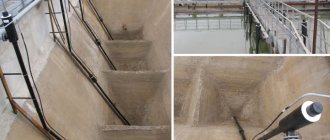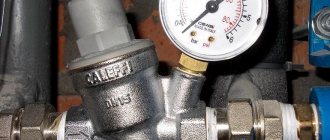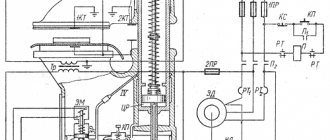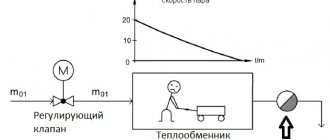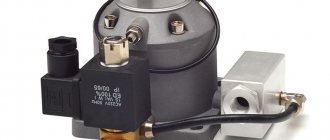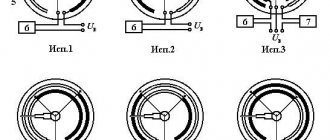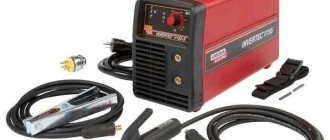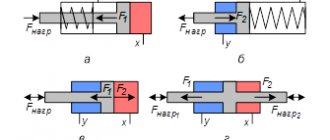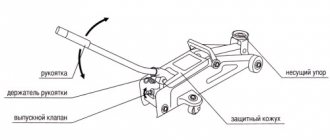Water jet ejectors VEZH
Domestic manufacturer of ejectors VEZH
Water-jet ejectors
Manufactured aluminum, copper, and steel parts provide high technical characteristics of Vezh ejectors produced by Kingisepp Machine-Building Plant LLC. Production is based on the use of domestic materials and raw materials, which, together with the use of modern metal processing technologies, makes it possible to produce high-quality water jet ejectors VEZH. The use of computer modeling allows, at the design stage, to take into account all the individual operating conditions of the parts being created, operating as part of various ship power plants and thermal systems.
Water-jet ejectors VEZH produced by KMZ
Ship water-jet ejectors VEZh are hydraulic devices, pumps, the basis of which is Bernoulli's law. When working, the water-jet ejector will create an area of low pressure in the area of narrowing the cross-section. As a result, the existing flow pressure decreases and causes a suction of another medium into the flow. In other words, a water-jet ejector acts as a water-jet pump, which creates a vacuum due to which the substance is pumped out. All products are issued with a PPP and RMRS certificate.
Water jet ejector: 1 – inlet pipe; 2 – nozzle; 3 – mixing chamber; 4 – diffuser.
Design diagram of water-jet ejectors VEZH
The device - VEZH (water jet ejector) is used on various types of ships where it is necessary to pump out water. In addition, it is actively used when it is necessary to clean certain objects that have been under water for a long time. It is also common to use a water-jet ejector VEZh to create a vacuum, as well as when it is necessary to remove non-condensable gases in technological equipment (thermal treatment of water supplied to boiler equipment).
Water-jet ejector VEZH
Range of products produced by VEZH
| Ejector | Ejector volumetric flow, m3/hour | Volumetric supply of working fluid VI3/hour | Pressure at the ejector inlet, MPa t0.05 | Pressure Ejector m | efficiency, % |
| VEZh 2.5 | 2.5 | 2.4 | |||
| VEZh 4 | 4.0 | 3.9 | |||
| VEZh 6.3 | 6.3 | 6.1 | |||
| VEZh 10 | 10.0 | 9.7 | |||
| VEZh 16 | 16.0 | 15.4 | |||
| VEZh 25 | 25.0 | 24.0 | |||
| VEZh 40 | 40.0 | 38.0 | |||
| VEZh 63 | 63.0 | 61.0 | 0.7 | 10 | 24.5 |
| VEZh 100 | 100.0 | 91.5 | |||
| VEZh 160 | 160.0 | 154.0 | |||
| VEZh 250 | 250.0 | 240.0 | |||
| VEZh 400 | 400.0 | 385.0 |
Notes:
- When using stationary drainage ejectors (or sweepers), the nominal flow is 0.8 of the nominal water flow.
- Ejectors of the proposed series can operate in various modes, including at an inlet pressure of 0.3 - 0.4 MPa, while the performance characteristics are determined additionally.
Vezh waterjet ejector body blanks
Water-jet ejectors are used for vacuum deaerators, as gas suction devices.
The ejector includes a nozzle to which working water is supplied; in due time, the vapor-gas mixture enters the inlet chamber. The ejector has a so-called mixing chamber. The vapor-gas mixture condenses in the initial section of the working water flowing out of the nozzle, and the remaining steam condenses in the mixing chamber and diffuser. It is here that the mixing of water and air takes place, as well as the increase in overall pressure. The water-gas emulsion is discharged from the ejector into the working water tank. Portable water jet ejectors with open threaded ends:
| Ejector index | L, mm | H, mm | Weight, kg |
| VEZhP 6.3 | 493 | 165 | 2,7 |
| VEZhP 25 | 828 | 230 | 7,4 |
| VEZhP 63 | 1177 | 300 | 25,0 |
| VEZhP 100 | 1490 | 340 | 46,0 |
The process of manufacturing the nozzle, assembling and welding the water-jet ejector VES
The plant's staff consists of qualified specialists from the shipbuilding and defense industries, which ensures high quality products. The structure of the company, in addition to the main production, includes design and technology departments. The company's workshops are equipped with a full range of metalworking equipment. In addition to the CPU processing centers, universal turning, milling, grinding, erosion, welding and thermal equipment are used in effective interaction. Competent management allows us to carry out a closed cycle of work on the design and manufacture of various types of products, technological equipment, molds, and stamps with the highest quality and speed.
Structure and principle of operation
According to the method of operation, a self-priming pump can be vortex and centrifugal. In both, the key link is the impeller, only it has a different structure and is installed in a housing of different dimensions. This changes the principle of operation.
Centrifugal
Centrifugal self-priming pumps have an interesting working chamber structure - in the form of a snail. The impellers are fixed in the center of the housing. There can be one wheel, then the pump is called a single-stage, or there can be several - a multi-stage design. Single-stage ones always operate at the same power, multi-stage ones can change performance depending on conditions, and accordingly are more economical (consuming less electricity).
Self-priming centrifugal pump device
The main working element in this design is a wheel with blades. The blades are bent in the opposite direction relative to the movement of the wheel. When moving, they seem to push the water, squeezing it towards the walls of the body. This phenomenon is called centrifugal force, and the area between the blades and the wall is called a “diffuser”. So, the impeller moves, creating an area of increased pressure at the periphery and pushing water towards the outlet pipe.
Diagram of water movement in a centrifugal pump
At the same time, a zone of reduced pressure is formed in the center of the impeller. Water is sucked into it from the supply pipeline (suction line). In the picture above, the incoming water is indicated by yellow arrows. Then it is pushed towards the walls by the impeller and rises to the top due to centrifugal force. This process is constant and endless, repeating as long as the shaft rotates.
The principle of operation of centrifugal pumps is associated with their disadvantage: the impeller cannot create centrifugal force from air, so the housing is filled with water before operation. Since pumps often operate in intermittent mode, so that water does not flow out of the housing when stopped, a check valve is installed on the suction pipe. These are the features of the operation of centrifugal self-priming pumps. If the check valve (it must be present) on the supply pipeline is at the bottom, the entire pipeline has to be filled, and this will require more than one liter.
| Name | Power | Pressure | Maximum suction depth | Performance | Housing material | Connection dimensions | Price |
| Caliber NBC-380 | 380 W | 25 m | 9 m | 28 l/min | cast iron | 1 inch | 32$ |
| Metabo P 3300 G | 900 W | 45 m | 8 m | 55 l/min | cast iron (stainless steel drive shaft) | 1 inch | 87$ |
| BISON ZNS-600 | 600 W | 35 m | 8 m | 50 l/min | plastic | 1 inch | 71$ |
| Elitech NS 400V | 400W | 35 m | 8 m | 40 l/min | cast iron | 25 mm | 42$ |
| PATRIOT QB70 | 750 W | 65 m | 8 m | 60 l/min | plastic | 1 inch | 58$ |
| Gilex Jumbo 70/50 Ch 3700 | 1100 W | 50 m | 9 m (built-in ejector) | 70 l/min | cast iron | 1 inch | 122$ |
| BELAMOS XI 13 | 1200 W | 50 m | 8 m | 65 l/min | stainless steel | 1 inch | 125$ |
| BELAMOS XA 06 | 600 W | 33 m | 8 m | 47 l/min | cast iron | 1 inch | 75$ |
Vortex
The vortex self-priming pump is distinguished by the structure of its casing and impeller. The impeller is a disk with short radial baffles located at the edges. It's called an impeller.
Structure of a vortex pump
The housing is made in such a way that it quite tightly covers the “flat” part of the impeller, and there is a significant lateral gap in the area of the partitions. When the impeller rotates, water is carried along by the bridges. Due to the action of the centrifugal force, it is pressed against the walls, but after some distance it again falls into the zone of action of the partitions, receiving an additional portion of energy. Thus, in the gaps it also twists into vortices. This results in a double vortex flow, which is what gave the equipment its name.
Due to the peculiarities of their operation, vortex pumps can create a pressure 3-7 times higher than centrifugal pumps (with the same wheel sizes and rotation speed). They are ideal when low flow and high pressure are required. Another plus is that they can pump a mixture of water and air, sometimes even creating a vacuum if they are filled only with air. This makes it easier to put it into operation - there is no need to fill the chamber with water or a small amount is enough. The disadvantage of vortex pumps is their low efficiency. It cannot be higher than 45-50%.
| Name | Power | Pressure (lifting height) | Performance | Suction depth | Housing material | Price |
| LEO XKSm 60-1 | 370 W | 40 m | 40 l/min | 9 m | cast iron | 24$ |
| LEO XKSm 80-1 | 750 W | 70 m | 60 l/min | 9 m | cast iron | 89$ |
| AKO QB 60 | 370 W | 30 m | 28 l/min | 8 m | cast iron | 47$ |
| AKO QB 70 | 550 W | 45 m | 40 l/min | 8 m | cast iron | 68 $ |
| Pedrollo PKm 60 | 370 W | 40 m | 40 l/min | 8 m | cast iron | 77$ |
| Pedrollo RK 65 | 500 W | 55 m | 50 l/min | 8 m | cast iron | 124$ |
Choice: built-in or external?
Depending on the installation location, there are remote and built-in ejectors. There is no big difference in the design features of these devices, but the location of the ejector still affects in some way both the installation of the pumping station and its operation. So, built-in ejectors are usually placed inside the pump housing or in close proximity to it.
As a result, the ejector takes up minimal space and does not have to be installed separately; it is enough to carry out the usual installation of the pumping station or the pump itself. In addition, the ejector located in the housing is reliably protected from contamination. Vacuum and reverse water intake are carried out directly in the pump housing. There is no need to install additional filters to protect the ejector from clogging with sludge particles or sand.
A remote ejector for a pumping station is more difficult to install than an internal model, but this option creates a much less noise effect
However, it should be remembered that this model demonstrates maximum efficiency at shallow depths, up to 10 meters. Pumps with a built-in ejector are designed for such relatively shallow sources; their advantage is that they provide excellent incoming water pressure.
As a result, these characteristics are sufficient to use water not only for domestic needs, but also for irrigation or other economic operations. Another problem is the increased noise level, since the vibration of the operating pump is added to the sound effect of water passing through the ejector.
If you decide to install a pump with a built-in ejector, you will have to take special care of sound insulation. It is recommended to install pumps or pumping stations with a built-in ejector outside the house, for example, in a separate building or in a well caisson. The electric motor for a pump with an ejector must be more powerful than for a similar model without an ejector.
An external or external ejector is installed at a certain distance from the pump, and this distance can be quite significant: 20-40 meters, some experts even consider 50 meters acceptable. Thus, a remote ejector can be placed directly in a water source, for example, in a well.
The external ejector does not so much increase the pump’s performance as it is designed to increase the depth of water intake from the source, which can reach 20-45 m
Of course, the noise from the operation of an ejector installed deep underground will no longer disturb the residents of the house. However, this type of device must be connected to the system using a recirculation pipe through which the water will return to the ejector. The greater the installation depth of the device, the longer the pipe will have to be lowered into the well or well.
It is better to provide for the presence of another pipe in the well at the design stage of the device. Connecting a remote ejector also involves installing a separate storage tank from which water will be drawn for recirculation.
Such a tank allows you to reduce the load on the surface pump, saving some energy. It is worth noting that the operating efficiency of the external ejector is somewhat lower than that of models built into the pump, however, the ability to significantly increase the intake depth makes one come to terms with this drawback.
When using an external ejector, there is no need to place the pumping station directly near the water source. It can be installed in the basement of a residential building. The distance to the source can vary within 20-40 meters; this will not affect the performance of the pumping equipment.
Features and types of design
There are two types of ejector type pump:
- with external ejector location;
- with internal (built-in) ejector location.
The choice of one or another type of ejector layout is determined by the requirements for pumping equipment. To suck air from different containers, another type of such units is used - an air ejector. It has a slightly different operating principle. In our article we will study devices to facilitate pumping water.
Internal ejector
Pumping equipment with a built-in ejector has more compact dimensions. In addition, the creation of liquid pressure and its intake for recirculation occurs inside the pumping equipment
Pumping equipment with a built-in ejector has more compact dimensions. In addition, the creation of liquid pressure and its intake for recirculation occurs inside the pumping equipment. This pump uses a more powerful motor that can recirculate liquid.
The advantages of this design solution:
- the unit is not sensitive to heavy impurities in water (silt and sand);
- the water entering the equipment does not need to be filtered;
- the device is suitable for lifting water from a depth of no more than 8 m;
- Such pumping equipment provides sufficient liquid pressure for domestic needs.
Among the disadvantages it is worth noting the following:
- this pump makes a lot of noise during operation;
- To install such a unit, it is better to choose a place away from the house and build a special room.
External ejector
To install the ejector externally next to the pumping equipment, it is necessary to equip a tank into which to fill with water
To install the ejector externally next to the pumping equipment, it is necessary to equip a tank into which water should be collected. In this container the working pressure and the necessary vacuum will be created to facilitate the functioning of the pumping equipment. The ejector device itself is connected to that part of the pipeline that is immersed in the well. In this regard, there are restrictions on the diameter of the pipeline.
Advantages of a remote ejector:
- thanks to this design, it is possible to lift water from a significant depth (up to 50 m);
- it is possible to reduce the noise from the operation of pumping equipment;
- such a structure can be placed directly in the basement of the house;
- without reducing the efficiency of the pumping station, the ejector can be placed at a distance of 20-40 m from the well;
- Due to the fact that all the necessary equipment is in one place, it is easier to carry out repair and commissioning work, which contributes to a longer service life of the entire system.
Disadvantages of the external location of the ejector device:
- system performance is reduced by 30-35 percent;
- restrictions in the choice of pipeline diameter.
Built-in ejector
In this case, the intake of water for recirculation, as well as the creation of pressure in the ejector, is created in the pump itself. This arrangement makes it possible to reduce the size of the installation.
A pump with an internal ejector is practically not susceptible to the presence of suspended matter in the form of sand and silt. There is no need to necessarily filter the incoming water.
The station is used to collect water from a depth of up to 8 meters. It creates sufficient pressure to supply a large farm, where water is mainly used for irrigation.
The disadvantage of the internal ejector is the increased noise level during operation. It is best to install it outside a residential building, preferably in a separate utility room.
The electric motor is obviously selected to be more powerful so that it can also provide the recirculation system. However, this comparison is only relevant in a situation with a well depth of up to 10 meters. At greater depths, pumps with an ejector simply have no alternative, except perhaps the submersible type, which requires a well with a large diameter.
Homemade ejector for a pumping station - example of assembly
Almost everyone who has been involved in arranging an autonomous water supply has encountered the problem of insufficient water supply to the suction pump. From the physics course we know that atmospheric pressure allows water to be supplied from a maximum depth of 9 meters.
In practice, this figure decreases to 7 and even 5 m of confident delivery. An ejector for a pumping station will help solve the problem, allowing you to increase the water pressure. The industry produces such equipment, which is part of pumping stations and pumps.
Design and principle of operation of the installation
An ejector is a device that transfers the energy of a medium moving at high speed to another, less mobile one. In the tapering section of the apparatus, a zone of low pressure of one of the media appears, provoking the suction of the second medium into its flow.
This allows it to move and move away from the suction point, using the energy of the first medium to move.
Internal structure of the ejector. This equipment is used to provide additional meters of water lift and insure the pump or station against unwanted dry running in the event of a sudden drop in the well level
Installations with an internal ejector are intended for pumping water from shallow, no more than 8 m, wells, storage tanks, wells or reservoirs.
A distinctive feature of the device is its “self-priming” ability, which allows it to capture water located below the level of the inlet pipe. Therefore, for the device to operate correctly, it is necessary to first fill it with water.
The impeller of the device pumps liquid and sends it to the entrance to the ejector, thereby creating an ejection jet.
She accelerates as she moves along the tapering tube. Accordingly, the pressure inside the jet decreases. Thus, the pressure inside the suction chamber also decreases significantly.
If you connect a pipe to the inlet pipe and lower it into water, it will begin to be forcefully sucked into the device.
Pumping station with external (left) and internal (right) ejector. Equipment with a remote ejector can be installed at a considerable distance from the well or well
Another type of surface installation is a pumping station with a remote ejector. They are distinguished by the presence of an external ejector immersed in the source of water supply. The design and scope of application of the installations are generally the same as those of analogues with an internal ejector.
A significant difference is the ability to use the device at depths of more than 10 m. In addition, such pumps are extremely demanding on the conditions for installing an external ejector.
The pipes connecting it to the pump must be installed strictly vertically, otherwise the inlet line may become air-filled and become inoperable.
It is most optimal to use such a device to work at a depth of 15-20 m, although some manufacturers indicate a maximum depth of 45 m. It is clear that with increasing lifting height, the operating characteristics of the pump deteriorate. In general, devices with an external ejector have lower efficiency than those with an internal one.
It is only 30%. But they allow you to get rid of the noise created by the device, and make it possible to place the installation several tens of meters from the well.
Connection
In the case of an internal ejector, if it is included in the design of the pump itself, installation of the system is not much different from the installation of a non-ejector pump. It is enough to simply connect the pipeline from the well to the suction inlet of the pump and arrange a pressure line with associated equipment in the form of a hydraulic accumulator and automation that will control the operation of the system.
For pumps with an internal ejector, in which it is fixed separately, as well as for systems with an external ejector, two additional stages are added:
- An additional pipe is laid for recirculation from the pressure line of the pumping station to the ejector inlet. The main pipe from it is connected to the pump suction.
- A pipe with a check valve and a coarse filter is connected to the ejector suction for drawing water from the well.
If necessary, a valve is installed in the recirculation line for adjustment. This is especially beneficial if the water level in the well is much higher than the pumping station is designed for. You can reduce the pressure into the ejector and thereby increase the pressure in the water supply system. Some models have a built-in valve for such a setting. Its placement and adjustment method are indicated in the equipment instructions.
Initial launch and further operation
It is recommended to perform the initial start-up of the pumping station according to the following scheme:
- Pour water into the pump through the special hole.
- Turn off the tap through which water flows from the pumping station to the water supply system.
- Turn on the pump for about 10-20 seconds and turn it off immediately.
- Open the tap and bleed some of the air from the system.
- Repeat the cycle of short-term pump on/off in combination with bleeding air until the pipes are filled with water.
- Turn on the pump again.
- Wait until the accumulator is filled and the pump automatically turns off.
- Open any water tap.
- Wait until the water flows out of the accumulator and the pump turns on automatically.
If water does not flow when starting up a system with an ejector, it is possible that air is somehow leaking into the pipes, or the initial filling with water was not performed correctly. It makes sense to check the presence and condition of the check valve. If it is not there, the water will simply pour into the well, and the pipes will remain empty.
These points should also be taken into account when using a pumping station with an ejector, which is started after long-term storage. It is best to check the check valve, the integrity of the pipes and the tightness of the connections immediately.
If an ejector is needed to improve the water pressure in the system, and not to increase the depth of water intake, you can use the homemade ejector model described above.
